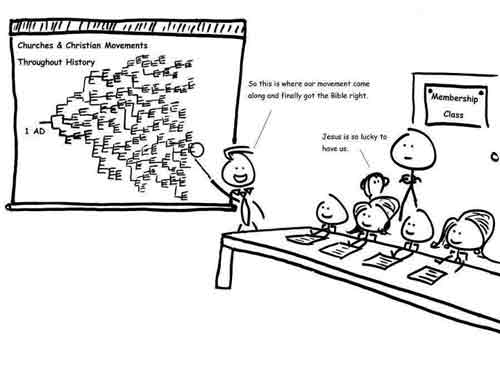
“So this is where our movement came along and finally got the Bible right”
“Jesus is so lucky to have us”

Appropriately on the feast day of St Benedict (for a blog interested in monasticism and liturgy)
The Anglican bishops meeting for the Lambeth Conference are following a consultative process called Indaba. This is reminiscent of Benedictine and other styles of meeting.
This Sunday, 27 July, Roman Catholics and Episcopalians and others will essentially pray the same prayer.
July 25 1968 Pope Paul VI published his Encyclical letter Humanae Vitae. His commissions, set up in response to the development of oral contraceptives in…
Lambeth Bible Study with Joanna Clegg A famous poet representing the other party (Alexander Pope), once said ‘know thyself, presume not God to scan; the…
This is absolutely hilarious! I wonder if there’s any way to blow it up a little bigger though… I had to squint and strain to see the text. This is SO worth sharing though 🙂
Thanks, Dan. I put the words underneath for the reason you point out. The image is as big as the blog style allows. Glad you appreciate it. Blessings.
I sure am glad I am NO LONGER a member of an invent-your-own church! Thanks be to God! I have come home to Rome, never more to roam!
Thanks, Kevin (KLB). Rome, on this very detailed, totally accurate diagram, is four branches to the left and three up from where the teacher is pointing 😉 Blessings.
I took a little break recently, driving through a lot of little country towns where there were church buildings shared between several denominations, and of course the cooperation between many denominations after the recent earthquakes in Christchurch (I was thinking of writing “shake up in Canterbury”, but that has other connotations)… all this working together is pretty much the opposite of the splintered history shown in the graph.
Apart from the two obvious serious questions this raises (“Are earthquakes actually a Good Thing?” and “What religious group is too anathema-ised to be associated with?”), there is the bigger question in today’s media-focussed, advertising-laden, sound-bite-fed world: what would you call a church (congregation/movement) that gets back to basics and reverses the schismification?? The signs outside the church buildings I saw took a lot of words to explain who were using the building and when, and where to find the people behind each denomination. Except for the few “Union” churches there was no catchy name to put a handle on the combination, and the mouthful of words tended to emphasise the separation of denominations.
When churches/movements have divided in the past, they tend to adopt names that either imply they are right (words that mean true, universal, primary, etc), or include the bit of theology they are upset about (seventh day, etc)… leaving “protest” and “Anglican” as silly choices, I guess. Perhaps that is for the best; if anyone called their movement “The Christian Church” they’d soon be causing no end of trouble when they say to somebody “you’re not included”, whereas nobody gets all that bothered at the moment being told they are not (say) an exclusive seventh-day theosophist, because, well, that’s just one of many things they’re not, and they’re probably very glad of the fact. But after a lot of accepting that the Church has been dividing again and again, we are too tolerant of division being normal.
Maybe the way to tackle the Anglican Covenant issue is to first tackle the “how do we get on with other Christians to the point we can all say we are part of the same bunch?” issue.
Yes, Mark – I think there’s much more that unites us than divides us. We are maybe focusing in the wrong direction. Blessings.
“Thanks, Kevin (KLB). Rome, on this very detailed, totally accurate diagram, is four branches to the left and three up from where the teacher is pointing”
Yes, it is detailed and accurate! I see that it begins with 1 AD, which means “1. Anglican Denomination”. 🙂
There is no religion, there is only God. God calls for love to all humans and to care for the earth, neither of which we have done.